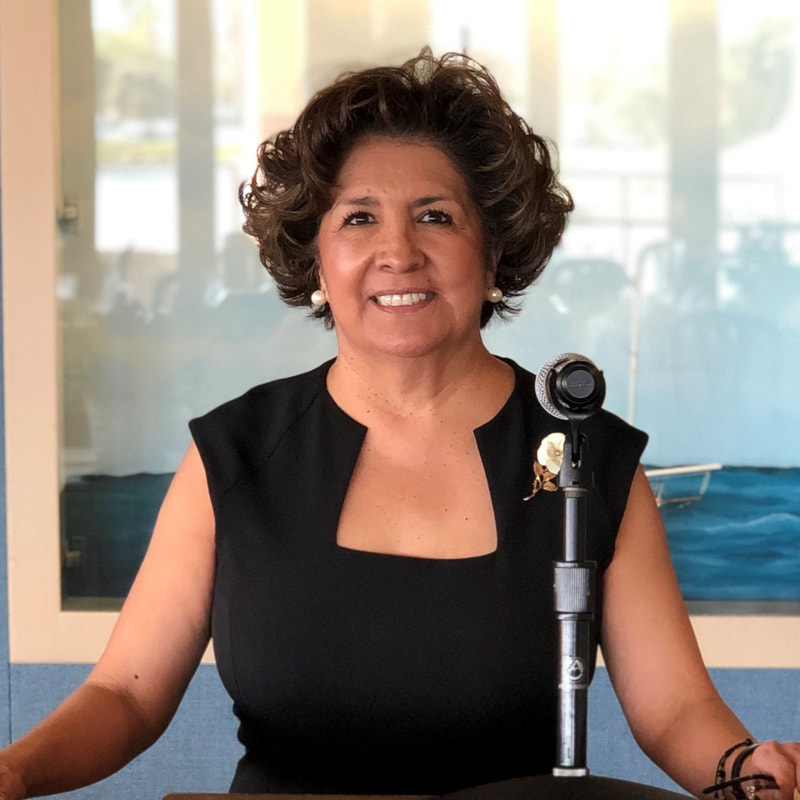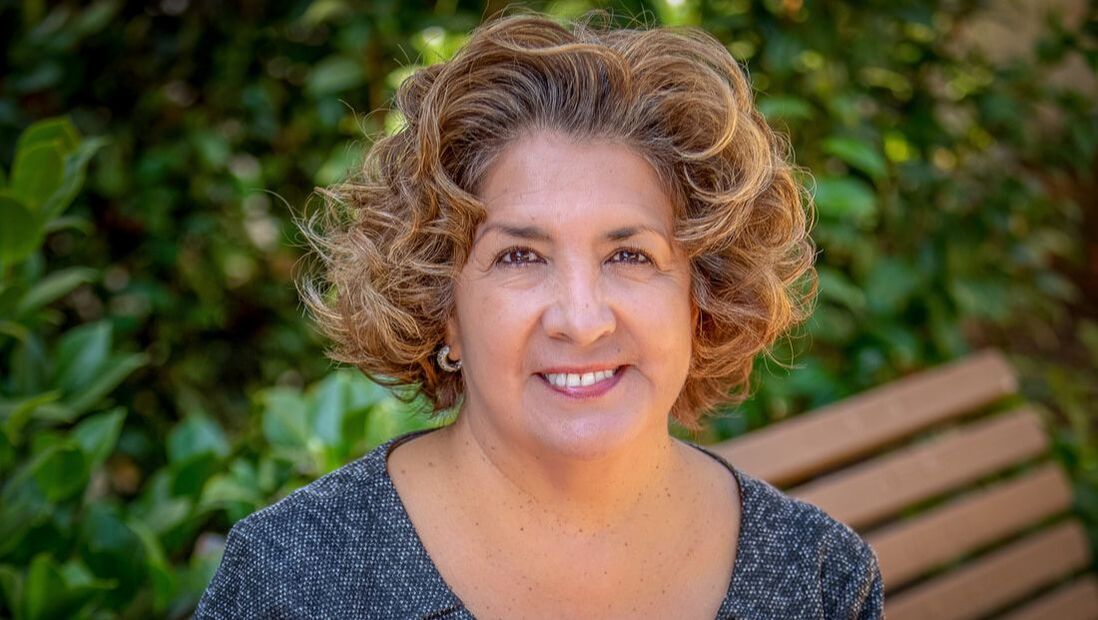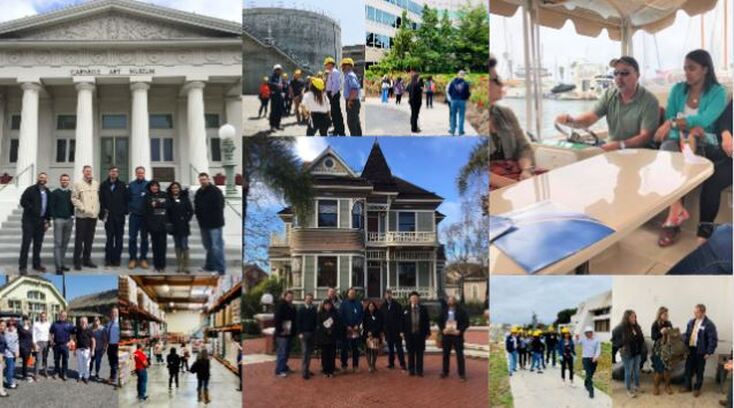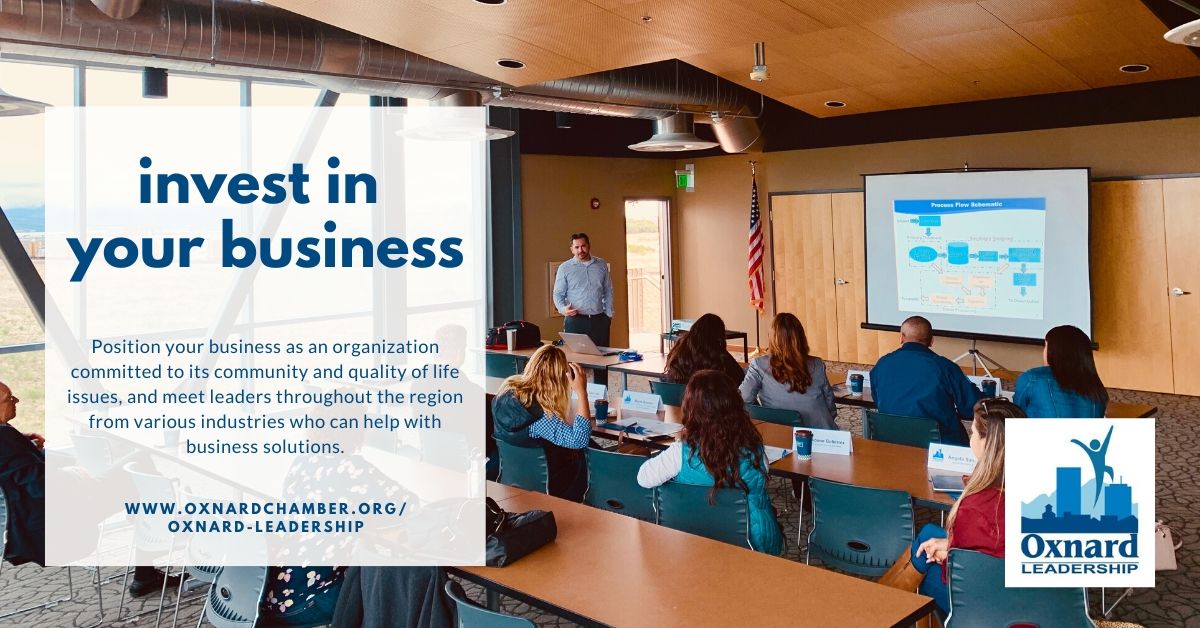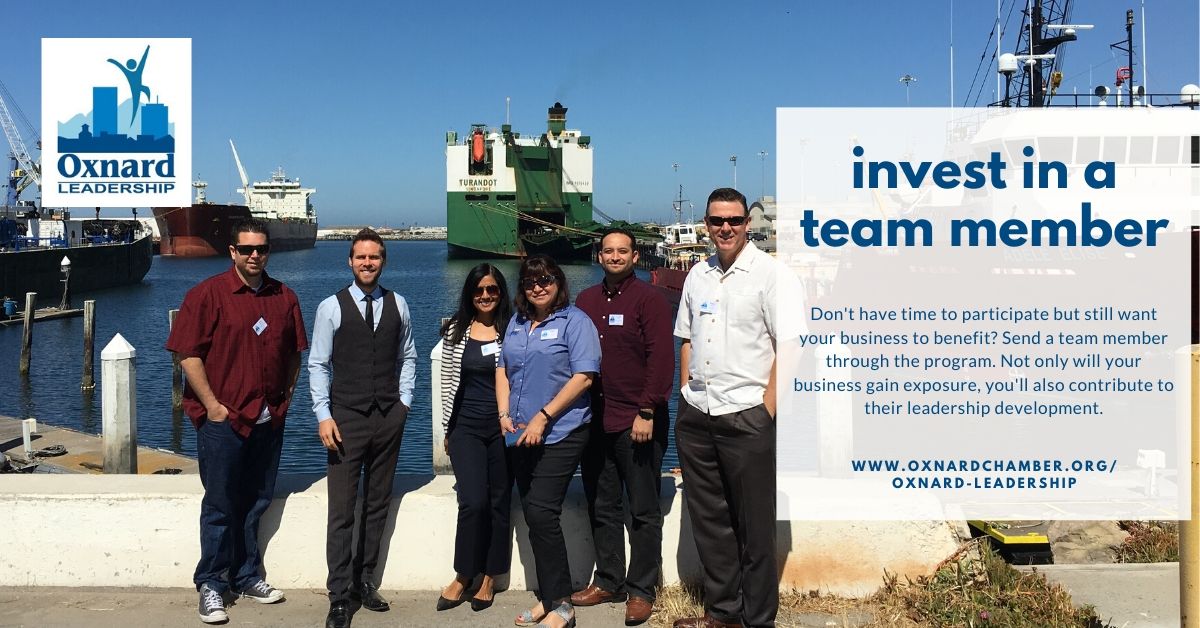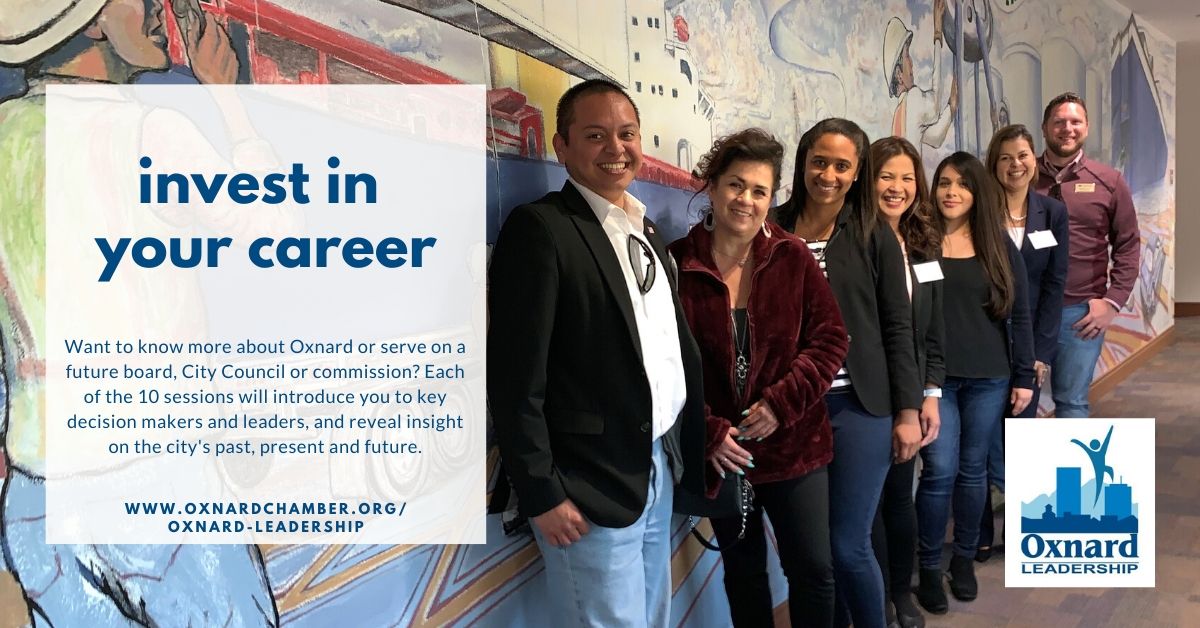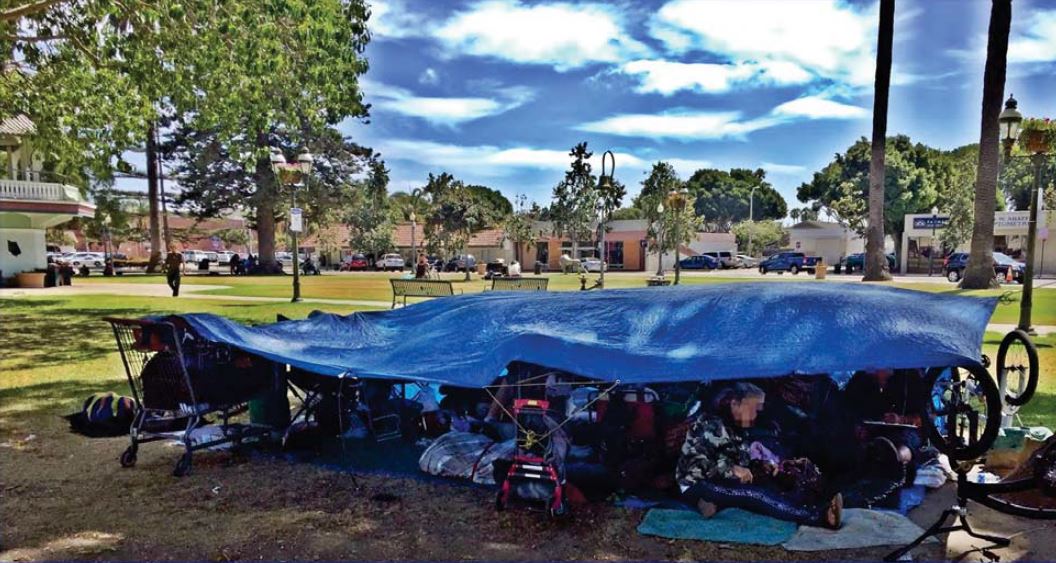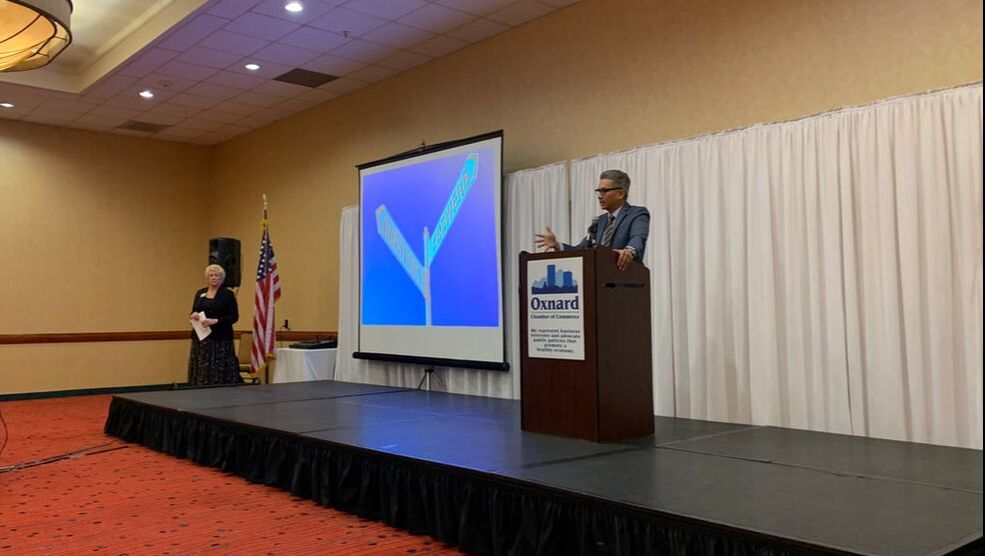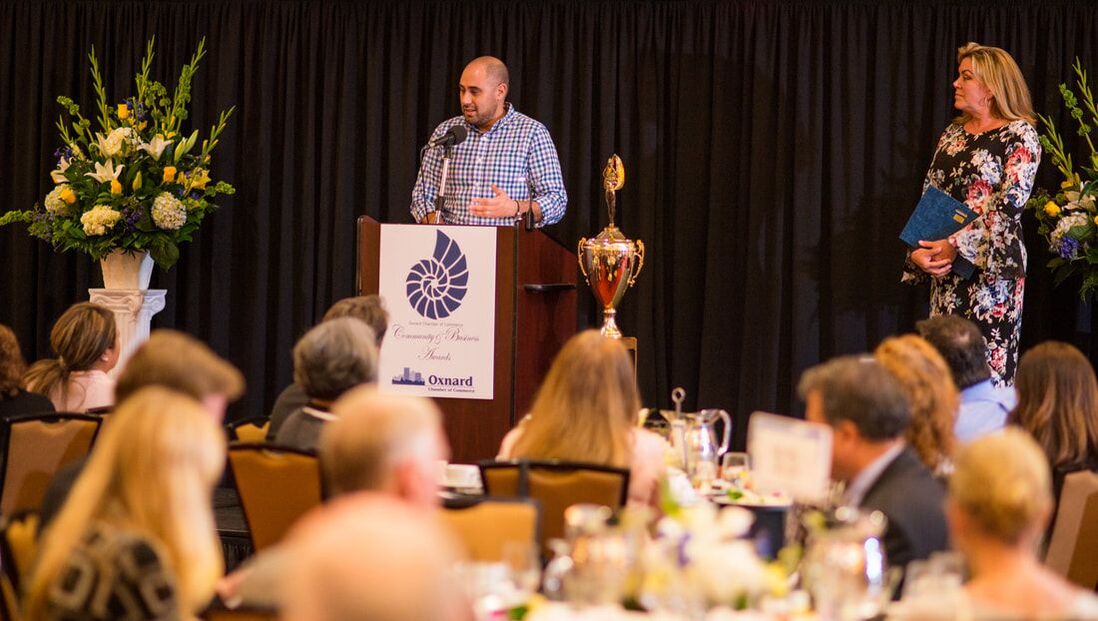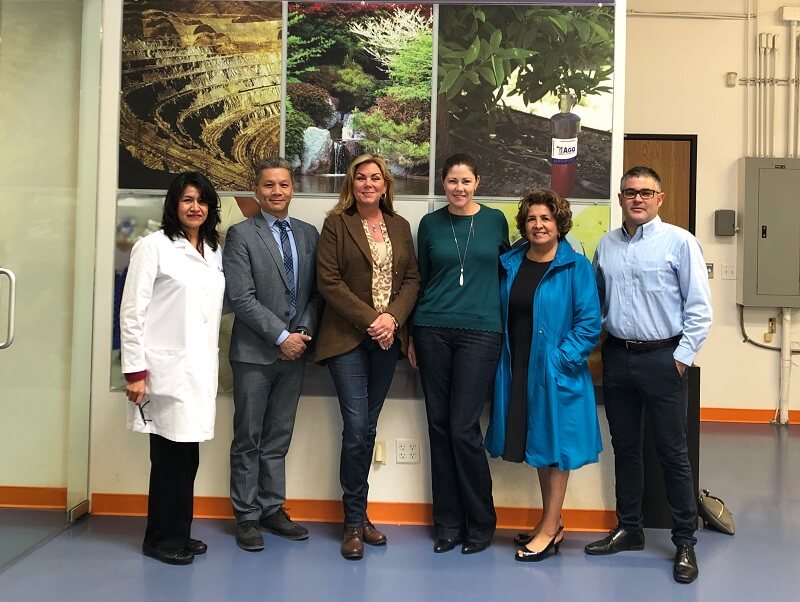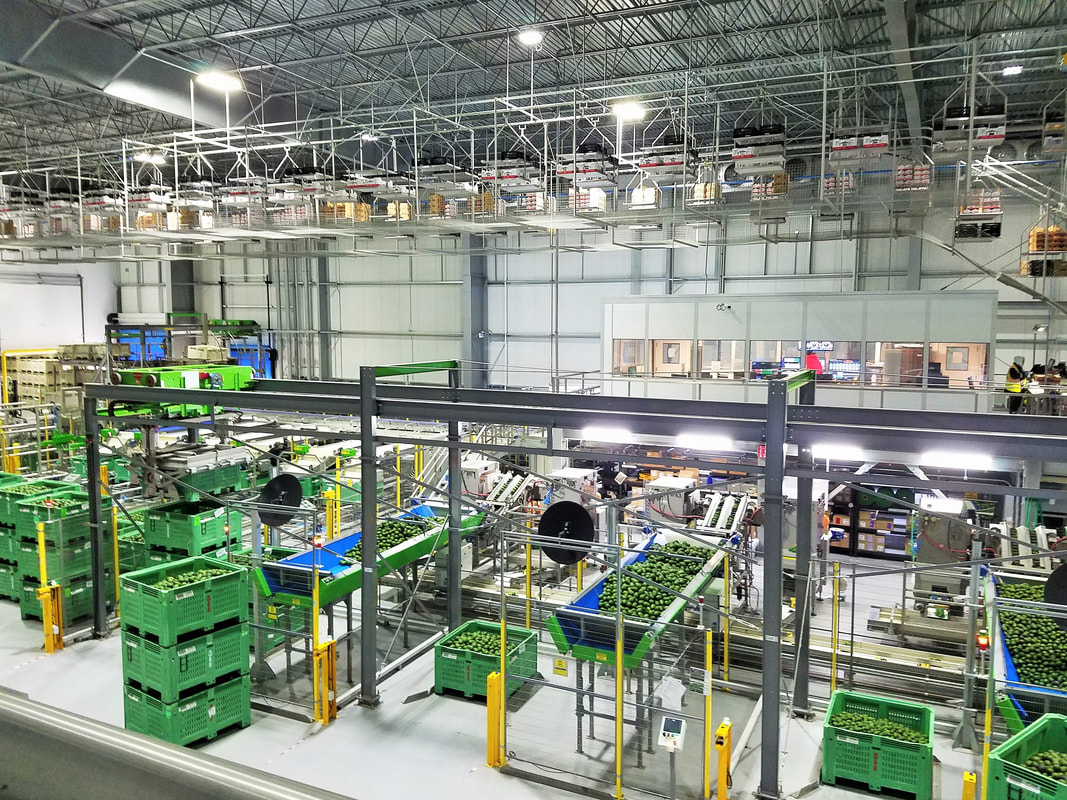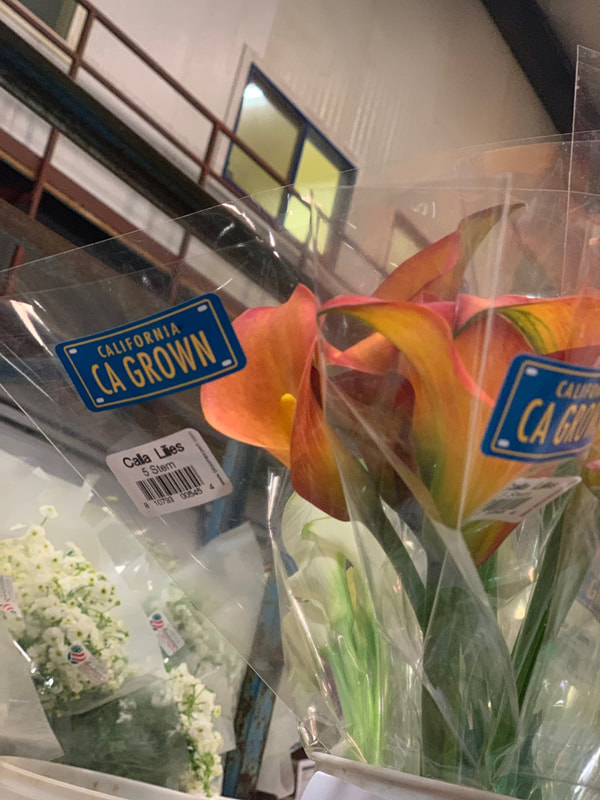|
By Chamber Chair Celina Zacarias Every 10 years we have the opportunity to participate in the U.S. Census and stand up to be counted. This year marks the next census. Beginning on Census day, April 1, 2020, and running through the end of July 2020, we have the opportunity to impact the future of our community for the next 10 years. Census data is used to evaluate each state, county, and community in a variety of ways. From an impact on infrastructure to an impact on local businesses, it is important that we all participate in the upcoming census. Ventura County has been identified as the 59th hardest-to-count county. Meaning that we are likely to be under-counted and therefore underrepresented and underfunded in the years to come. For every person that goes uncounted, it equates to approximately $2,000 per year in social safety-net benefits that go to fund things such as emergency services, infrastructure, improving schools, healthcare access for infants and children and many other essential social services our community relies on. The census does not only impact us personally but can have a significant impact on the business community. It is important know that an accurate count is vital to funding for rural business and industry development, job training programs, and other employment programs that impact the economic growth in our county. Census data is regularly used by businesses, developers, and economists to evaluate expansion, and new business ventures within our region. So we want to be sure that our community’s count represents the growing, thriving people we call family, friends, and neighbors. Additionally, the decennial census data will be utilized to determine the number of votes California has in the electoral college, the number of representatives in the House of Representatives and to potentially redraw State Assembly and Senate district lines. As we all know, having elected officials who believe in our community and support local businesses is important to our continued and future success. As members of the business community, here are a few practical ways you can help our community be counted:
As the Census approaches, let’s work together to make sure our community is counted and well represented in the decade ahead. If you have any questions about how you can get more involved with the Census effort, you can start by visiting https://venturacountycounts.org.
The Oxnard Chamber is delighted to welcome Celina Zacarias as our Chair of the Board for 2020. She has been on the Oxnard Chamber Board of Directors since 2015 and is Senior Director of Community and Government Relations at California State University Channel Islands (CSUCI). Here are five things to know about Celina.
1. She is a home-grown leader. Celina grew up in Oxnard’s La Colonia neighborhood and went to Channel Islands High School where she was on the dance drill team. She is the daughter of migrant farmworkers who worked in our local fields. Celina was born in Michoacán, Mexico and came to the United States at age 3. Both her father and grandfather were a part of the Bracero Program from 1942-1964, which brought millions of Mexican guest workers to the United States 2. She’s an advocate for higher education. Celina was the first in her family to go to college, graduating from UCSB with Bachelor of Arts degrees in Spanish literature and Hispanic civilization. She studied abroad in Cuba, China, the Czech Republic, Hong Kong and England. 3. She didn’t always work in education. For 25 years, Celina enjoyed a career in mortgage banking at GMAC Mortgage, Wells Fargo and Cabrillo Economic Development Corporation. She joined CSUCI in September 2007 as Senior Director of Community and Government Relations and is responsible for advancing the University’s positive presence and goodwill locally, nationally and internationally. 4. She’s an award-winning community leader. Celina’s contributions to the community have resulted in numerous accolades, including the Pacific Coast Business Times’ 2018 Latino Leadership Award, 2012 Top Latina in Higher Education Award and 2006 Top Woman in Business; the Oxnard Chamber's 2016 Distinguished Citizen, 2011 Chairman's Award of Excellence and 2007 Woman of the Year; and the American Red Cross’ 2007 Diversity Ambassador. 5. She is active throughout the community. Celina is Chair-elect of the Camarillo Chamber of Commerce, is on the Moorpark Chamber of Commerce’s Board, and was Chair of the Board of the Simi Valley Chamber of Commerce. She also is Chair of the Women’s Economic Roundtable, and on the Ventura County Civic Alliance Executive Committee, Workforce Development Board, Leadership California Executive Advisory Council and RDP-21 Board of Directors. Connect with Celina on LinkedIn Follow Celina on Twitter By Chamber Chair Stacy Miller It has been my honor to serve as your Chair of the Board for 2019. In addition to working with an excellent board of directors, Chamber CEO and staff, I have thoroughly enjoyed getting to know and work with the myriad of business and government leaders in Oxnard. These dedicated professionals regularly seek out ways to improve the business climate in our community, generously giving of their time and talent to improve Oxnard for the benefit of everyone. While Oxnard is known as Ventura County’s most populated community, it is also home to many amazing businesses that employ thousands of people. Over the last year, I have had the privilege of touring some of these businesses, including Haas Automation, Mission Produce and CURE Pharmaceutical to name a few. At all of these (and other) Oxnard-based businesses, I have been very impressed by their world-class technology and expertise in their fields; all right here in Oxnard! At the local government level, the Chamber works together with local leaders on issues ranging from land use and business regulations, to homelessness and housing. While we are not always in agreement on every issue, I have consistently experienced a great willingness on the part of our leaders to listen and consider varying ideas and opinions for the good of our community. It is my pleasure to share with you a few of the many accomplishments made by the Oxnard Chamber of Commerce in 2019, in partnership with the business and government communities:
I want to thank each and every one of you for your support and participation with the Oxnard Chamber of Commerce. Together we can continue to be the catalyst for business growth, the convener for leaders and influencers, and the champion for a stronger community.
By Chamber Chair Stacy Miller Now more than ever, our communities need good, hard-working and dedicated leaders. We need people who are willing to sacrifice their time and treasure for the good of others. We need these people to step up and serve but, first, we need them to be educated. That is where the Oxnard Chamber of Commerce's Oxnard Leadership Program comes in. This dynamic, 10-session course provides participants with relevant and accurate information about key local and regional issues, one-on-one time with proven leaders, and a network of contacts to take those next steps. Leadership is lifting a person's vision to high sights, the raising of a person's performance to a higher standard, the building of a personality beyond its normal limitations. The program is open to anyone however applicants need to have a desire and dedication to enhance their leadership potential; increase their knowledge of the community; and be willing to commit their individual talents in future years toward the betterment of Oxnard. The gains are tremendous and include:
“Whether you are new to the area or have lived here for years, this important program can open new doors of opportunity,” commented Shelly Merrell, President & CEO for Integrated Fire Safety. Shelly and I have each agreed to sponsor one participant as part of our commitment to future community leaders, I hope other leaders will join us in supporting this great program. If you or someone you know would benefit from this program, I encourage to complete the online application available from the Chamber’s website: www.oxnardchamber.org/oxnard-leadership.html. Let’s all help tomorrow’s leaders start learning today! The 10-session program focuses on one topic per all-day session: Session 1: Government Learn about the governmental structure of our region and meet with city and county-level elected officials as they share their experience and vision for our community. Session 2 - Public Safety Spend the day alongside Oxnard Police Department, SWAT, and take a behind-the-scenes tour of Ventura County Jail. Session 3 - Education Visit our local high schools and universities to see how they’re serving our young people and preparing the next generation of leaders. Session 4 - History, Parks & Museums Discover how our community was founded and experience our regions rich culture and history. Session 5 - International Trade & Defense Guided tours of The Port of Hueneme and Naval Base Ventura County will display the impact these institutions have on a local, regional and international level. Session 6 - Public Services Go behind-the-scenes to see how our city services operate on a daily basis. Past visits include the Advanced Water Purification Facility, Del Norte Regional Recycling, and the Wastewater Treatment Plant. Session 7 - Health & Human Services Visits to St. John’s Regional Medical Center and FOOD Share highlight the ways our community is serving the needs of a growing population. Session 8 - Commerce Discover your leadership style, learn about workforce development & business ethics, and visit some of our local businesses. Past visits have included Haas Automation and a boat tour of Channel Islands Harbor. Session 9 - Agriculture/Natural Resources Meet with the Ventura County Agricultural Commissioner, tour a local farm, and experience an incredible agricultural testing facility located right here in our own backyard. Session 10 - Energy Learn about oil and gas production in Ventura County and its impact here and abroad, discover alternative energy sources, and hear from experts in the field.
 By Chamber Chair Stacy Miller Drinking establishments are not what they used to be. In 2019, many of them, like craft breweries, seek to be family-friendly places of business. They not only serve craft beer, but also cater to families by providing a family-friendly atmosphere and activities for kids, like food trucks and board games. This is the case with two local establishments that reached out to the City of Oxnard and the Oxnard Chamber of Commerce, requesting assistance with lifting a regulation that prohibited anyone under 21 from entering. (This applied to craft breweries without a kitchen.) The craft brewery business-model focuses on providing a family-friendly environment where mom and dad can enjoy a cold one at the end of the day, while their children play safely nearby. Unfortunately, in Oxnard, unlike other neighboring cities, there was a regulation that prohibited people under 21 to accompany an adult to a craft brewery. When brought to the attention of Jeff Lambert, Oxnard’s Community Development Director, he did his research and realized that the City didn’t have the authority to put such a condition on the businesses and set in motion to make a change. And it worked; the restriction was lifted.
"It’s important that we continue to look for ways to make doing business in the city of Oxnard easier,” says Lambert. “We look forward to more opportunities to streamline and reduce red tape." How’s that for government working with local business? This is absolutely a case of win-win-win. The City wins because it will see more revenue from the businesses; the businesses win because they are seeing more sales, and patrons win because they are no longer restricted from bringing their children with them to their favorite craft beer hangout. The Oxnard Chamber extends its warmest thanks to the City of Oxnard for its forward-thinking approach to working with local businesses. Let’s keep this trend going! American economic growth is highly dependent on the quality and quantity of workers. Currently, the United States is facing a severe skilled and unskilled worker shortage that has long and short-term economic implications. - Global Risk Insights  By Chamber Chair Stacy Miller My professional mentor, a long-time city manager, loved to share his favorite story about good planning. It involved “The Seven Generation Stewardship,” a concept that urges the current generation of humans to live and work for the benefit of the seventh generation (140 years) into the future. The Seven Generation Stewardship principle is believed to have originated with the Iroquois Indians and encourages this forward thinking in all decisions, resulting in a sustainable world, seven generations into the future. I was reminded of this story during a recent presentation from Oxnard City Manager Alex Nguyen, who spoke of “Moore’s Law,” a computing term that originated around 1970. The simplified version of this law states that processor speeds, or overall processing power for computers, will double every two years. Alex was referring to Intel’s chips which have improved performance a factor of 3,500 since they were introduced, reflecting a 90,000-times improvement in energy efficiency and at one-60,000th of the cost. Had a 1971 Volkswagen Beetle undergone the same transformation, it would now travel at 300,000 miles per hour, achieve two million miles per gallon, and cost four cents. Wow! Moore’s Law became a guiding light for an industry. Moore’s original article also envisioned a future for cheaper, more powerful semiconductors. He envisioned PCs, cell phones, self-driving cars and electronic wristwatches—all powered by ever-improving chips. Both the Seven Generation Stewardship concept and Moore’s Law demonstrate the importance of true forward-planning and efficiency. Alex’s point, however, hits a little closer to home. Like many of us, Alex is very concerned that today’s workforce is ill-prepared for tomorrow’s jobs, which as he points out, are here now. Here in Oxnard, one of the top issues we hear from employers is a lack of trained and educated workers. There are local jobs waiting to be filled and employers are frustrated with the lack of candidates applying that just don’t meet the necessary criteria for the jobs. For the first time in our country, there are more job openings than there are eligible workers to fill them. So how did we get here? There are several trends that have contributed to this. One of these is “The Silver Tsunami,” whereby 45% of the current workforce will be retiring and/or leaving the workforce within the next decade. Another trend is the growth of the temporary worker. The rise of temporary workers is a workforce trend that’s here to stay and there are predictions that 40% of the workforce will be contingent on temporary workers by 2020. According to the U.S. Bureau of Labor Statistics, temporary workers make up 19% of all new jobs in the U.S. By 2020, more than 40 percent of the U.S. workforce are expected to be temporary or contingent workers. Just these two trends alone—people leaving the full-time workforce and the growing number of temporary workers--are big contributors to our lack of adequate, qualified employees. According to "The Atlantic," it’s estimated that the U.S. economy will need as many as 100,000 new information technology workers every year for the next decade. By 2026, there will be 2.6 million new jobs in healthcare, one-fifth of all new jobs. The changing demand for specific skills is being felt across industries and, as a result, companies and organizations are investing in programs that empower the workforce of the future through job retraining. So, what is being done locally and around the country?
But many workers are finding that job retraining alone is not enough. Support networks and social services are needed to support the transition to new types of work. What else is being done here in Oxnard and Ventura County? I would love to hear from you! Please email me your thoughts and ideas at: [email protected].  By Chair of the Board Stacy Miller It’s no secret that cities across the country are dealing with the impacts of homelessness. In Oxnard, Ventura County’s largest city, lives the county’s largest number of homeless, estimated at about 700 individuals. For Oxnard City Manager Alex Nguyen, it is a daily work effort for his staff and the Oxnard Police Department that has cost the city $3.2 million over two years. “It is frustrating to hear people say that the city isn’t doing anything to deal with the impacts of homelessness in Oxnard,” laments Nguyen. "There isn’t a day that goes by that we aren’t responding to calls regarding issues surrounding homeless individuals.” Nguyen’s frustration centers on the fact that the funding approved by California voters is slow in making its way to cities that deal with the issues every day. In fact, the state has about $2 billion in housing and homeless funding, but those funds are not being provided for the day-to-day urgent problems cities confront. “The city does not condone vagrancy. We are spending millions on police services and code enforcement, all of which do nothing to get anyone off the street for any length of time,” he stated. Nguyen subscribes to the “housing first” model, which, according to the National Alliance to End Homelessness, is a homeless assistance approach that prioritizes providing permanent housing to people experiencing homelessness thus ending their homelessness and serving as a platform from which they can pursue personal goals and improve their quality of life. This approach is guided by the belief that people need necessities like food and a place to live before attending to anything less critical, such as getting a job, budgeting or attending to substance abuse and mental health issues. But that costs money which Nguyen believes is the responsibility of the state. Right now, Nguyen and his team are working with various partners, including neighboring cities, Ventura County and private developers, to identify potential sites in Oxnard for future housing, utilizing eventual state and other funding sources. “If communities are going to really make an impact with homelessness, then it is going to take the combined efforts of government, business, nonprofit organizations and individuals,” he said. “This is one of the big challenges of our era that will require active participation, funding and coordination on many levels." How Businesses Can Help
For Oxnard-based businesses dealing with the day-to-day impacts of homelessness, the issue is a volatile one. Businesses have expressed frustration with public intoxication, trash and other homelessness issues that hamper their businesses. But rather than just complain, Nguyen is urging businesses to be a small part of the solution. “Businesses can help the issue by doing a few simple things: consider cutting hedges around their businesses to prevent people from sleeping there; consider bringing on private security; and also be willing to hire one or two formerly homeless individuals,” explains Nguyen. “Having a job is a vital component of regaining life stability.” While it is important that everyone do their part, Nguyen emphasizes that the ultimate funding source is the state, and if cities don’t receive direct funding to fight homelessness, we all will continue to experience degrading quality of life. “The state currently provides direct funding through the biggest 13 cities. This is very frustrating for local governments. Every day we are spending money and time on everything from chasing down shopping carts and cleaning up trash, to responding to calls about public urination and vagrancy,” adds Nguyen. “There are so many other things we need to get done in Oxnard but if we don’t do a better job of housing the homeless, we won’t be able to get there." Clearly, our city manager is frustrated with the lack of financial and other assistance to aid the homelessness crisis. Please consider contacting your elected officials and the governor’s office regarding this important issue. CURE Pharmaceutical is changing how we take our medicines By Chair of the Board Stacy Miller Imagine a daily regimen of several pills, liquids or injections being reduced to a simple small film that dissolves in your mouth. You don’t have to just imagine this great innovation because it is already developed by the brilliant team at CURE Pharmaceutical based right here in Oxnard. CURE Pharmaceutical is a vertically integrated life science company with a propriety platform for oral drug delivery. The CURE mission is to improve lives by redefining how medicines are delivered and experienced, enabling more precise dosing and better efficiencies for patients. By partnering with innovative firms looking for new methods to deliver drugs from early feasibility to commercialization, CURE Pharmaceutical is utilizing cutting-edge technology to solve a myriad of drug delivery issues. “CURE’s oral soluble film technology is a versatile formulation platform that allows CURE to create proprietary drug products with optimal release profiles for better patient outcomes and experiences,” explains Jessica Rousset, CURE Pharmaceutical’s Chief Operating Officer. From young children to the elderly and some in-between, the experience of taking pills, liquids and injections can be difficult. This can lead to poor medication adherence. When swallowed, pills need to be dissolved by the body into particles small enough to be absorbed. During this process, as much as 80% of the drug may get metabolized by the liver and excreted. While liquids can be offered as an alternative delivery method, they often taste terrible and can be challenging to administer to children and pets. Also, many patients strongly dislike injections, particularly when self-administered. CUREfilm®, CURE Pharmaceutical’s marquis drug delivery system, is revolutionizing how medicines are consumed, solving the issues some have with pills, liquids and injections. CURE’s oral dissolving film technology unleashes the full potential of drug treatments and can improve the efficacy and safety of new and existing drugs, match or improve pharmacokinetic drug profiles, and stabilize plasma levels over extended time periods, possibly reducing dose frequency and side effects. With CURE’s patented technology, life-saving drugs can be delivered to patients that bypass the G.I. tract, avoiding G.I. side effects and in activation in the gut and liver. This method protects the active ingredient from degradation in the biological environment; it prolongs the drug’s presence in the blood, and it increases cellular uptake. CURE’s technology is different from other oral thin films in that larger amounts of the drug active can be loaded onto the CUREfilm®. Patient benefits of the CUREfilm® include rapid delivery for faster clinical affect and symptom relief; reduced side effects with a possible lower dose; an alternative to swallowing pills and injections; and easier adherence by combining multiple actives in one dose. What else is on the horizon for this innovative company? How about raising the bar for cannabis by maximizing how cannabis can be used as an effective therapy for patients? “We are very excited about the momentum at CURE Pharmaceutical. We are always looking at being collaborative not competitive, and we live by our company’s mission to improve people’s lives by redefining how medicines are delivered and experienced,” says Rousset. What a great innovator right here in Oxnard! Check out CURE Pharmaceutical at: www.curepharma.com.  By Chair of the Board Stacy Miller “Our work tells you the facts. We don’t tell you to eat or not to eat this or that, we just tell the truth.” That’s how CEO of AGQ Labs Tenesor Peña describes the company's goals and mission. Keeping to the facts is a good thing when you’re a science lab responsible for chemical analysis of food and soil. It’s exactly the type of science gaining public notice in the wake of a rising consumer base that wants to know what’s in their food and how it’s grown. AGQ’s Oxnard lab focuses their work solely on food safety and agronomy, the science of soil management and crop production. Their work is highly sought after by agriculture business looking to take their farms and produce into the future. How does analysis from a lab like AGQ make a difference? “We give growers a lot of helpful information,” says Peña. “We can show growers how much water and fertilizer they need so they don’t waste resources. Take nitrogen, for example. Too much means the extra will leech into the soil. Our analysis will prevent overdoing it and in turn, be better for your soil because you’re only giving your crops exactly what they need.” Saving resources, saving money and creating better soil means long-term benefits for growers from season to season. AGQ Labs is more than just a standout business partner for growers. Over the last eight years since opening in Oxnard, it’s become an engaged community partner. Why is Oxnard the place for its only lab in the United States? Why is Oxnard ideal for a cutting-edge laboratory with global ties and nine labs all over the world? “Oxnard really was a perfect fit for our agronomy work. It’s close to growers and the Ag industry, and close to an international airport, which helps us maintain our global ties and send and receive samples internationally. It's an affordable and beautiful city to build a lab,” explains Peña. He also says the city openly welcomed AGQ and, because of that goodwill, he believes strongly in giving back to the community. AGQ is a partner in Ventura Farm Day, offering an open house and free public tours alongside local farms. Peña himself is a member of the Board of Directors of the Chamber of Commerce and lives locally in Oxnard, like his employees (a team of 40), who all live local in the Oxnard and Ventura County area. AGQ Labs is growing their local engagement through business connections, educational partnerships with Cal State Channel Islands, Cal Poly and Ventura College, and even supporting local youth soccer teams. In addition to hosting a recent tour of the lab for Oxnard Chamber leadership and city management, AGQ loves to host tours for local children. “We like to show kids where their food comes from," states Peña. “It’s our way to teach the next generation.” Proof AGQ is growing more than just good science right here in Oxnard.  By Chair of the Board Stacy Miller Sgt. Ron Helus, 54, of the Ventura County Sheriff’s Department was one year away from retirement after 29 years on the job, but he was the first to enter the Borderline Bar and Grill on that fateful night when 12 people lost their lives in a mass shooting last November. That was the kind of dedication Ventura County Sheriff’s Department Sgt. Ron Helus had, protecting others before himself. On Saturday, June 29, our community has an opportunity to show respect and appreciation for Sgt. Helus and other members of law enforcement as part of the Ride for the Blue event. If you are a motorcyclist, the Ride for the Blue event will start at the parking lot of Borderline Bar and Grill in Thousand Oaks, 99 Rolling Oaks Dr. Thousand Oaks, with registration beginning at 6:45 a.m. The actual motorcycle ride will begin at 7:50 a.m., with a lunch break at 12:30 p.m. and the event ending at 4:00 p.m. Participants will ride their motorcycles and briefly visit each law enforcement station in Ventura County to say thank you to the officers who are protecting and serving our communities. If you would like to show your support for the Oxnard Police Department, we invite you and your family to meet in front of the Oxnard Police Department, 251 S. C Street, Oxnard. You should plan on being at the station at approximately 10:45 a.m. on June 29 to support and cheer on our dedicated law enforcement personnel and the hundreds of riders visiting our great city. The event is free and open to the community to participate. More information and registration is available at ridefortheblue.com, or you may call the event coordinator John Short III at (800) 606-1390 or email him at [email protected]. I hope you can join our local enforcement for this important event to show appreciation and support for those who work so hard every day to keep our community safe.  By Chair of the Board Stacy Miller Considered one of the healthiest foods on the planet and great when mixed with chopped onions and cilantro, California-grown avocados are beloved around the world. In Oxnard, Mission Produce has been answering the international call for this superfood for the last 35 years by producing the world’s finest avocados. Mission Produce of Oxnard is the largest avocado provider in the world with long-term, year-round retail and food service relationships throughout North America, Europe and Asia. Mission Produce houses North America’s largest and the world’s most technologically-advanced packing facility, packing 1,000 pallets of fruit daily. During the growing season, the Oxnard facility employs 202 employees. Internationally, Mission employs nearly 3,000 employees. Mission Produce got its start by packing and marketing avocados from Oxnard, California. Today, Mission continues to pack and market throughout the sunny coastal areas of California and has developed partnerships with the state’s top growers to provide high-quality avocados to markets all over the globe. Mission Produce celebrates its strong ties to our community by supporting several organizations and events including the Big Brother/Big Sister organization, Make-a-Wish Foundation, Food Share, American Heart Association of Ventura County, Casa Pacifica and the Ventura County Fair’s Kids in Agriculture program. Thank you, Mission Produce, for your investment and commitment to Oxnard! Is This Avocado Ripe? If you are one of those people who needs to feel your avocados prior to purchasing them, then according to Mission Produce avocado experts, you are selecting your avocados correctly. “It’s all in the feel—color is not an indicator of ripeness. The best way to judge ripeness is to feel for uniform softness,” explains Denise Junqueiro, Director of Marketing for Mission Produce. Your avocado’s not ripe enough to eat? Here’s a tip from Mission Produce: Place avocados in a brown paper bag with an apple or banana. Close the bag and leave on the counter or windowsill for 24-48 hours. Check periodically. The avocado ripening process is stimulated by the release of ethylene gas from its companion fruits. Once the avocados have reached desired ripeness, they can be stored in the refrigerator for several days. Need More Reasons to Enjoy Oxnard-Grown Avocados? According to WebMD, avocados offer nearly 20 vitamins and minerals in every serving, including potassium (which helps control blood pressure), lutein (which is good for your eyes), and folate (which is crucial for cell repair and during pregnancy). Avocados are a good source of B vitamins, which help you fight off disease and infection. They also give you vitamins C and E, plus natural plant chemicals that may help prevent cancer. Avocados are low in sugar and contain fiber, which helps you feel full longer. In one study, people who added a fresh avocado half to their lunch were less interested in eating during the next three hours.  By Chair of the Board Stacy Miller Would you be surprised to learn that 99% of all security alarm calls in Oxnard during 2018 were actually false alarms? Business and commercial false alarms totaled 3,103 and residential false alarms totaled 1,720. As the use of commercial and residential security alarm systems increases, so has the incidence of false alarms. False alarms cost police departments across the country more than the time and resources spent on response; they divert attention and resources away from genuine law enforcement needs. When our police officers respond to a false alarm, it competes with real emergency calls for service. It is also expensive and an inefficient use of the Oxnard Police Department’s time and resources. To help reduce the number of false alarms and promote alarm user responsibility, the City of Oxnard adopted a new ordinance which calls for fines to alarm users who generate excessive alarm call responses. Excessive is defined as the occurrence of two or more false alarms, generated by an alarm user’s alarm system within a 12-month period. The fine is $145 for the second false alarm and each one thereafter within a year’s time period. Locations with over five false alarm responses in a 12-month period may be subject to an alarm permit suspension or revocation. A suspension or revocation will result in fines up to $290 per response. If your Oxnard-based business or home has a security alarm, you’d better also have a security alarm permit; a requirement of a city ordinance that costs $25 a year. Alarm users without a valid permit and have an alarm-generated police response to their site will be subject to a fine. You can download the alarm permit application at: www.oxnardpd.org/alarm-permits. If you accidentally activate your security alarm at your home or business, you should contact your alarm company immediately if they do not call you. If you cannot recite the property’s password or code word over the phone to the alarm operator, the police will be dispatched. Let’s all do our part to help reduce the number of false alarms in our community so that our fine Oxnard Police Department can be available to quickly respond to real emergencies. For more information regarding the alarm program, contact the Oxnard Police Alarm Administrator at (805) 385-7672 or at [email protected]. 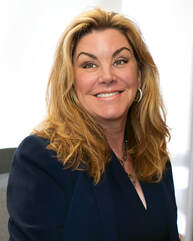 A message from the Chair of the Board Stacy Miller "The earth laughs in flowers." ― Ralph Waldo Emerson Nothing says spring quite like a colorful bouquet of fresh flowers and, in Oxnard, we enjoy some of the most beautiful blossoms grown right here. Would you be surprised to know that Oxnard is home to a floral company that employs 200-300 people, boasts 60 acres of floral farms and 1.3 million square feet of greenhouse space growing flowers that are shipped throughout the U.S.? Farm fresh and California-grown, Sun Valley Floral Farms flowers are available locally at Trader Joe’s, Whole Foods, Ralph’s, Vons and through flower wholesalers. You can even send Oxnard-grown flowers as a gift via www.flowerbud.com. In 2001, Sun Valley acquired Pleasant Valley Flowers, Inc. and Golden Coast Nurseries in Oxnard, which enhanced their product line with additional greenhouse capacity. The Sun Valley Floral Farms Oxnard Division currently produces lilies, irises, matsumoto asters, lisianthus, calla lilies and delphinium, as well as other seasonal flowers. “About 80 percent of flowers sold in the U.S. are grown in Columbia and Ecuador. Our flowers are all grown in California and we encourage flower buyers to look for the 'CA Grown' license plate logo on our products,” explains Bill Prescott, Marketing Communications Specialist for the Sun Valley Floral Farms. Sun Valley prides itself on utilizing practices that are of an ecological nature and promote sustainable floriculture. Sun Valley received the prestigious Rainforest Alliance Sustainable Agriculture Standard Certification, which signals to consumers that their flowers were grown in a responsible, ethical and sustainable manner. Sun Valley Floral Farms was the first California farm to qualify for this certification and challenged fellow growers and shippers to adhere to the guidelines because it is the right thing to do. “At the Sun Valley Floral Farms, we aim to be stewards of the earth and work in harmony with nature to create amazing cut flowers that are safe for farmers to grow and promote healthy soil,” explains Prescott. “The highly recognizable Rainforest Alliance ‘green frog’ seal has been an essential part of our marketing since we achieved certification in 2017,” he added. A little-known fact about a favorite lily varietal: The Sun Valley Floral Farms developed the Stargazer lily in their Humboldt County facility and named it to recognize the fact that this beautiful flower points up to the stars rather than pointing down like other varieties of lily. If you are interested in learning more about this amazing Oxnard-based business, visit their website. A message from the Chair of the Board, Stacy Miller
What do custom outdoor umbrellas, high-end drums, ice cream, top-line machine tools and gourmet macarons have in common? All of these internationally-sold items are made right here in Oxnard! Oxnard is home to an amazing array of creative (and delicious) manufacturing companies, each with its own unique story and success. Santa Barbara Designs has it MADE IN THE SHADE with its world-renowned production facility in Oxnard. Santa Barbara Designs uses locally-sourced materials and vendors from our community to create elegant outdoor umbrellas. Completely customizable, these gorgeous umbrellas can be found in some of the world’s finest private residences, yacht clubs, luxury hotels, exclusive restaurants and high-profile corporate facilities. I’m hoping my husband will purchase one for our house, they are truly works of art! www.santabarbaradesigns.com. When Gene Haas founded Haas Automation Inc. in 1983, his goal was to manufacture economical and reliable machine tools. The company entered the machine tool industry with the first-ever, fully automatic, programmable collet indexer – a device used to position parts for machining with very high accuracy. The patented Haas 5C collet indexer was a huge success, and over the next four years, the company expanded its product line to include a wide selection of fully programmable rotary tables, rotary indexers, and machine tool accessories. All Haas products are manufactured at the company’s expansive facility in Oxnard– the largest, most modern machine tool manufacturing operation in the United States. These guys aren’t just tooling around! www.haascnc.com. Follow the beat of the drum to DW Drums, a world-renowned manufacturer of drums with nearly five decades of success located in Oxnard. According to professional musicians, touring the DW Drum factory in Oxnard is every drummer’s dream. DW Drums is considered to be the biggest manufacturer of drums on the planet. The light wood colored drum is considered the “Rolls Royce” of drum kits. The 45th Anniversary Exotic Stradivarius 6-Piece Shell Pack retails for about $8,000 and is made of the same wood (hand-selected Norwegian Spruce from the Fiemme Valley in Northern Italy) that Stradivarius violins are made from; only about 650 original Stradivari instruments remain in existence, and these sell for millions of dollars. Beat that! www.dwdrums.com. McConnell’s Ice Cream has been scooping up fans for decades with its made from scratch, no preservatives, pure-flavored ice cream. McConnell’s Ice Cream manufacturing plant has been based in Oxnard since 2017 where the delicious, local, sustainable and organic 70-year tradition of ice cream is made for all of the McConnell stores. They had me at ice cream! www.mcconnells.com. One of the sweetest manufacturers in Oxnard is Duverger Macarons. Each of its macarons is confectioned in Oxnard, using the best fruits, berries, nuts and almond flour. Owner and Chef Claire Becker’s passion is creating two slightly crispy shells with a lush enticing filling. She says that Duverger macrons will melt in your mouth and slowly release the taste of its raw ingredients. (Wiping drool now), I think I will need a taste test to confirm, thanks Claire. www.duvergermacarons.com. These businesses are just a handful of many businesses that create amazing products purchased world-wide and are located right here in Oxnard. Congratulations to all of our MADE IN OXNARD businesses and manufacturing companies. We appreciate your contributions of employment, business-to-business purchasing and support of non-profits for the benefit of our community. MADE IN AMERICA & MADE IN OXNARD!  A message from the Chair of the Board Stacy Miller The Oxnard Chamber of Commerce is pleased to welcome Jeff Lambert, the City of Oxnard’s new Director of Development Services. In his new job, Jeff will oversee the City’s planning, building and engineering and code enforcement divisions. He will also be working with the City Manager’s office to participate in the City’s Economic Development priorities to ensure the City has a prosperous future. “I am personally excited to work with Oxnard’s many and diverse stakeholders to move the City forward. The City has so much to offer and my job will be to help put all the pieces together to realize the community and City Council’s vision for our future,” explains Jeff Lambert. “I love that I can use the word “our’ for Oxnard after being in Ventura County for nearly 10 years. I am also excited to get to know the community, spend time in the neighborhoods and work with those interested in investing in Oxnard. Our future depends on balancing neighborhood preservation and revitalization while seeking new opportunities to provide needed housing, jobs and amenities for our community,” Lambert continued. Jeff says he first brings a commitment to community to this job. He promises to be engaged and accessible to the community and its stakeholders. Jeff has a long track record of bringing people together to get things done; this includes supporting and developing a staff team that shares this commitment and is equally excited about doing the community’s business. “I have had a unique career for a public servant in that I have worked in both the public and private sector; I understand first-hand what it is to be a customer of Development Services. I believe this experience will serve me and the City of Oxnard well.” Jeff believes that cities, including Oxnard, cannot stay the same; they must look to a prosperous future and to do that it is important to support existing businesses with a strategy of business retention, expansion and attraction. “I know what it takes to revitalize our downtown and will do my part to ensure this long-held dream is a reality,” Lambert said. Jeff earned a Bachelor’s degree from Clark University in Massachusetts in political science and psychology, and a Master’s degree in planning from USC. Jeff Lambert can be reached via email at: [email protected].  Stacy Miller Stacy Miller The Oxnard Chamber of Commerce is pleased to share a number of great accomplishments for 2018 that reflect a strong and growing business community. This year, we celebrated 110 years of service to the Oxnard business community. While business has changed dramatically over the last century-plus, your Chamber’s commitment to helping businesses thrive in Oxnard remains steadfast. With a mighty membership of 478, this year saw an increase of 71 new members—that’s an 11% increase over last year. 319 members choose to renew their membership, reflecting a 5% increase over last year. The Chamber’s Business Voice newsletter is emailed to every member and this year, there were 48 issues including a new addition to the newsletter, "5 Things" we did for business in the past week. The Oxnard Chamber values education that is strategic for its members and this year, we hosted seven knowledge and networking luncheons, including two candidates’ forums, as well as 10 educational sessions of the Oxnard Leadership program. The Chamber’s “Oxnard Young Professionals” group reached 35 members. This is definitely an area we are seeking to grow in the years ahead. The Chamber PAC (Political Action Committee) held a successful fundraiser aboard the Scarlett Belle and was instrumental in 5 of the 7 Chamber-endorsed candidates being elected or re-elected in November. The Chamber celebrated new businesses locating to Oxnard by co-hosting 13 ribbon cutting and groundbreaking ceremonies throughout the year. Helping members get to know one another and encouraging more business to business relationships is vital to growing businesses and this year, the Chamber hosted 10 happy hour mixers and four new member mingle receptions. I hope that you find your Oxnard Chamber of Commerce membership valuable and were able to participate in at least one of these great successes. If you didn’t participate in any of these events or programs, know that the Oxnard Chamber is still working for your business through its strong advocacy programs. We encourage you to get engaged because 2019 promises to be even better! Thank you for your support of the Oxnard Chamber of Commerce. On behalf of the Board of Directors and staff, we wish you and hour family a joyous holiday season. Stacy  Message from the Chair - Stacy Miller Travel spending is at an all-time high, with continued projections for more growth in 2019. The City of Oxnard is outperforming our neighboring cities across the board in hotel statistics. Year to date, occupancy is up 5% over last year at a strong 80.5%. Last year, visitor spending reached $1.7 billion in Ventura County. The tourism industry supported over 16,000 jobs in Ventura County and generated over $132 million in local tax revenue. Oxnard’s average daily rate is up 5.7% over last year at an impressive $155.40; the highest in the County and our RevPAR (Revenue per available room) is up 10.5% over last year at $125.00. This number is truly amazing and again we are outshining our neighboring cities in all of these areas. Oxnard is definitely gaining visibility and market share so it’s a good thing that over the next couple years, we will be welcoming three new hotel properties to further promote tourism. The Oxnard Convention and Visitors Bureau, “Visit Oxnard” actively promotes our beautiful community in a variety of ways. They utilize the traditional methods of media releases, print advertising in many different meeting and leisure publications, a monthly e-newsletter covering all the must do activities while in Oxnard, as well as outdoor advertising--(Happy Holiday’s from Visit Oxnard will showcase on the 101 in a couple of weeks). Visit Oxnard has a robust social media presence with 12.5k followers on Instagram and over 30k followers on Facebook. The Visit Oxnard team also enjoys a strong presence at meeting and leisure tradeshows and conferences. The Oxnard Convention and Visitors Bureau recently completed a top-notch visitors’ magazine showcasing Oxnard hotels, restaurants, attractions, and our diverse and vibrant community, events and festivals. The guide is featured in 444 locations throughout California and Arizona as well as at over 100 businesses in Oxnard and every hotel room in our community. “The Visit Oxnard team is so fortunate to represent such a spirited community. We have everything to fulfill any desire of any type of vacationer. From our Historic Downtown, to our pristine beaches and Channel Islands Harbor, to shopping galore, and some of the best taquerias in the State! We apricate the ability to showcase our variety of businesses, our stunning hotel properties and the community that makes up Oxnard,” explains Julie Mino, President and CEO, Oxnard Convention and Visitors Bureau. If you would like a free copy of the new visitors magazine, you can download it via the Oxnard Convention and Visitors Bureau website at: VisitOxnard.com. You can also request a copy be mailed to you by calling the office at 805-385-7545 to request copies for your home or business. Kudos to the team at the Oxnard Convention and Visitors Bureau for helping to increase tourism to Oxnard! OXNARD LOOKING TO INCREASE ECONOMIC COMPETITIVENESS WITH INTERNET SURVEY, FIBER MASTER PLAN11/6/2018
 A message from our Chair - Stacy Miller In an effort to ensure that current and future Oxnard-based businesses have the high-speed Internet services and connectivity they need, the City of Oxnard has released a Broadband Internet business survey and embarked on the development of a new Fiber Master Plan. The survey includes questions related to current connections, current Internet speed, costs for services and how well current broadband meets the business consumers’ needs at this time. The deadline for completing the survey is November 16, 2018. All businesses that complete the survey will be entered into a drawing to win a $100 Amazon gift card. The Broadband Internet survey is available online via the City’s website at: https://www.oxnard.org/fiber. In this day and age, access to reliable Broadband Internet services is a vital part of a city’s infrastructure—equally as important as streets, water, parks and sewers. Furthermore, Broadband connectivity enhances a City’s economic development potential by helping attract new, advanced businesses, as well as providing necessary Internet connectivity and services for existing businesses. While other Broadband technologies exist using copper and wireless, the use of fiber is much more future-proof. Internet speed demand is estimated to reach gigabit speeds by 2020. The next wave of technologies, especially artificial intelligence, demands increasingly robust connections from both home and office. Fiber technology is critical to the future of the smart home and the Smart City, since many of today’s most connected cities determined that laying fiber is the foundation upon which many of tomorrow’s most connected services will be built. Currently in the City of Oxnard, there is an existing network backbone that spans 38.45 miles of underground conduit with fiber running through about 31.81 miles of that conduit. Additionally, the City maintains 38 fixed wireless links between traffic signal locations. There is an additional 6.64 miles of conduit and fiber optic cable designed and planned for the expansion of the traffic signal network and other systems. We applaud the City of Oxnard for capitalizing on this unique opportunity to leverage its existing fiber network by expanding from a closed, private network supporting limited City buildings and systems, to a more open network platform that can be utilized for public, economic and social benefit. “Becoming a ‘Fiber City’ will help attract investment and support new business growth by providing access to robust, high-speed Internet and data networks,” said Kevin Pisacich, Oxnard’s IT Manager of Communications and Security Systems. “Gigabit fiber becomes almost like a renewable natural resource that benefits everyone for years to come. My vision for this network is that it will be the foundational infrastructure investment for the City that will provide high speed Internet services for businesses and residents as well as countless modern Smart City initiatives” said Keith Brooks, Information Technology Director for the City of Oxnard. We couldn’t agree more! The City has selected Magellan Advisors as its partner in developing its new Fiber Master Plan. The new master plan will pave the way to guide the design, construction, implementation, maintenance, management, regulation, operation and funding of the City’s fiber-optic assets and related technologies. To learn more about the project and complete the survey, visit the City’s website at https://www.oxnard.org/fiber. Remember, the City needs Oxnard-based businesses immediate input in completing the Internet survey by November 16th. 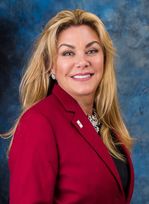 MESSAGE FROM THE OXNARD CHAMBER OF COMMERCE CHAIR Stacy Miller – October 2018 When you think of Oxnard, likely the beautiful beaches, well-appointed marinas, close-knit neighborhoods, excellent festivals and amazing weather come to mind. But now, Oxnard is also home to Northrop Grumman, thanks to the company’s relocation to a new manufacturing center. Northrop Grumman is one of the world's largest aerospace and defense technology companies and is utilizing their new Oxnard-based Astro Aerospace facility to design unmanned aircraft that can patrol the ground and sea. The new facility, located at 2601 Camino Del Sol in Oxnard, encompasses approximately 140,000 square feet, enabling concurrent manufacturing of large satellite reflectors, and other space hardware and deployable structures. Now in its 60th year, Astro Aerospace specializes in deployable structures with unmatched 100 percent success performance on-orbit including extendable/retractable boom and mast subsystems, deployable mesh reflectors, and other deployable planar structures, solar arrays and antennas. Further, they are developing solutions that prevent cyber threats from becoming cyber-attacks, and discovering trends to stay ahead of disease outbreaks. The company, which has tripled its workforce since 2017, is no stranger to Oxnard as they already have some presence here locally at the Naval Base Ventura County and also in Port Hueneme. Northrop Grumman’s new high-tech center brings nearly 300 employees to Oxnard, which contributes to our local economy. From the City of Oxnard’s perspective, they would love to see more of this type of industry in Oxnard. Councilmember Bryan McDonald said: “If you bring in a corporation or business and help them grow and become bigger, they create other job opportunities for suppliers and vendors. I think we are going to see a huge increase in our aerospace industry because they are going to attract other customers and other business here.” We at the Oxnard Chamber of Commerce couldn’t agree more and welcome Northrop Grumman’s Astro Aerospace facility to our beautiful community. 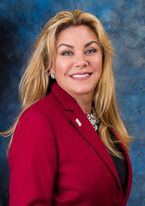 Message from the Chair, Stacy Miller Community policing team will meet individual businesses to address issues of concern If you are a business owner/manager in Oxnard struggling with issues related to crime, violence, vagrancy or vandalism, you may be interested in the Oxnard Police Department’s Business Engagement program. Started in 2016, the partnership-oriented program was created to help businesses reduce and prevent crime through police best practices. As part of the Business Engagement program, the Oxnard PD has created Neighborhood Policing Teams. The teams are divided among 11 geographic areas (beats) throughout the city with a community-policing officer assigned to each area. The officers work in their “beats” on specific business and community-related issues. Each Beat Coordinator is expected to be responsive to the needs of the community and works to build relationships with local business owners. The Police Beat Coordinator is “problem solver” with a variety of responsibilities including identifying crime trends and addressing quality of life issues such as homelessness and vagrancy with the idea that building relationships between the police and the people they serve is a great way to reduce and prevent crime. It looks like the Oxnard PD is on the right track. Crime has decreased in the city of Oxnard and this year, Oxnard PD was presented with a prestigious statewide award for its community policing work. Earlier this year, Chief Scott Whitney was quoted in the VC Star as saying: “Community policing is really a philosophy. It’s a way of policing where the department accepts the idea that it is partnered with the people it serves and where police count on residents to communicate, participate and, if need be, serve as witnesses.” You may be surprised to learn that crime prevention through environmental design is a real thing! As part of the Business Engagement program, the beat officers will come to your place of business and walk your property with you, offering small insights and suggestions for changes that can go a long way towards preventing crime. Some of these suggestions may include adding more lighting in strategic areas, trimming bushes that block windows, and my personal favorite, moving the beer away from the front door where it can easily be stolen. “We will come out to individual businesses to get to know owners and managers and understand the particular issues they are concerned about. We also collaborate as Beat Coordinators, sharing information across the beats that may reveal crime trends that we can work to solve,” explains Sgt. Jeff McGreevy, Neighborhood Policing Team Supervisor for the Oxnard PD. It is important that businesses flourish in Oxnard and the Oxnard PD’s Business Engagement program can help businesses deal with their individual issues related to crime, which is a big step in the right direction. Successful neighborhood policing is good for the economy and the community. When businesses are successful, the tax base increases and helps to pay for important quality of life projects and programs that make our city great. If you would like to contact your Beat Coordinator to access these free resources, call Sgt. Jeff McGreevy, the Neighborhood Policing Team Supervisor at 805-385-7600 or 805-797-8021. He can also schedule a custom presentation for your organization, neighborhood group or business regarding crime prevention.  By Stacy Miller, Chair of the Oxnard Chamber Board of Directors In case you missed it, a federal bill aimed at attracting private investment was passed at the end of December 2017 (Tax Cuts & Jobs Act). The bill allows the Governor to designate certain census tracts as Opportunity Zones. The good news is that there are three of these areas that have been designated in Oxnard: Rose Park, Colonia and Five Points Northeast. These areas, which were selected by the state and federal government based on areas of poverty, include: the area east of Rose Avenue to the eastern city limits between Highway 101 and Fifth Street, plus an area south of Fifth Street that is bounded by Oxnard Boulevard and Rose Avenue. What this means is that investments made by individuals through special funds in these zones would be allowed to defer or eliminate federal taxes on capital gains; a great incentive for private investment! The designated tracts include a mix of residential, commercial and manufacturing so investors can tailor their investments in these areas. The designation of an Opportunity Zones was hailed by the City of Oxnard as “a tool to stimulate economic growth.” By way of background, the Governor can designate up to 25% of census tracts that either have poverty rates of at least 20% or median family incomes of no more than 80% of statewide or metropolitan area family incomes. There are 3,516 census tracts in 54 California counties that would qualify under one or both of the mandatory criteria, allowing the Governor to designate up to 879 tracts. As census tracts are designed to capture geographic areas of around 4,000 people, more than three million Californians would potentially be located in one of these Opportunity Zone areas. The Opportunity Zone provides investors with opportunities to purchase and rehab properties, start a business or to build on raw land. This is attractive to investors because they can defer, reduce or even eliminate taxes paid on capital gains income by investing in a special qualified opportunity zone fund. It’s a great time to invest in Oxnard! The City of Oxnard stands ready, willing and able to discuss the Opportunity Zone program with interested investors. To find out more, contact the City of Oxnard’s Economic Development department at 805-385-7407. 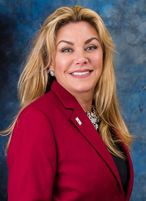 How $159 Million Benefits Oxnard at the Channel Islands Harbor By: Stacy Miller, Chair of the Board Would you be surprised to learn that the businesses and tenants of Channel Islands Harbor had a total economic impact of more than $159 million in 2016 (direct and indirect), according to a report recently published by the California Economic Forecast? Our little gem on the coast is credited with $74 million of direct economic impact to the Ventura County economy in 2016. The Channel Islands Harbor, which is one of the few growing employment centers in the County, also facilitated 920 full-time-equivalent jobs. The report anticipates that two proposed developments, including the Hyatt House and restaurant (formerly the Casa Sirena Hotel) and redevelopment of Fisherman’s Wharf (east side) could increase economic activity by over 60 percent. The highest performing business category for the Harbor in 2016 was dining, which grossed an estimated $19 million in sales. Real estate was the next highest performing category at nearly $12 million in gross sales. The remaining categories, in rank order of gross sales were: boating services, hotels, sportfishing, commercial fishing, personal services, other recreation, boat sales, yacht clubs, other retail, healthcare, insurance, boating supplies, education and home services. Back in the 1960’s and 70’s, the Channel Islands Harbor was built as a recreational harbor on 310 acres of land and water, with about 2,150 boat slips, as well as marina facilities, restaurants, sportfishing facilities and shops. In 2016, the marinas were 70 percent full. The Channel Islands Harbor is divided into three areas (west, east and peninsula) served by separate public roads, with each area providing different services. The west side includes marinas, a linear park, restaurants, residential development and retail businesses. The peninsula is dominated by hotel development, marinas, apartments and condominiums. The east side is primarily commercial and serves boaters by offering boat yards, a marine supply store, boat sales, law enforcement, administration and search and rescue facilities. It's that east side that really needs a makeover to generate more revenue and become the destination it was intended to be. Owned and operated by the County of Ventura, the majority of the Harbor is operated by businesses that have been granted long-term ground leases by the Ventura County Board of Supervisors Since 2012, Channel Islands Harbor business activity outperformed overall business growth throughout Ventura County, at 6.3 percent annually. The Hyatt House is a 206-room hotel with a 5,400 square foot restaurant. This $25 million project is expected to begin construction later this year. Fisherman’s Wharf at the Channel Islands Harbor (www.fishermanswharfoxnard.com) is a proposed $100 million mixed use project that includes high-end apartments, restaurants, shops and commercial development to replace the dilapidated Fisherman’s Wharf at the Channel Islands Harbor. Good things are happening in Oxnard and with the addition of a new hotel and proposed mixed-use project, our Channel Islands Harbor will be the shiniest gem on the California coast! Here’s to a great future! Stacy The economic impact study, which was released in 2018, can be found at: channelislandsharbor.org. 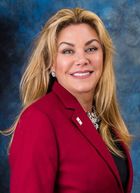 Stacy Miller Stacy Miller Message for our Chair, Stacy Miller The year was 1908. The Ford Motor Company produced the first “Model T” at its Detroit factory. The first Boy Scout handbook, “Scouting for Boys” was published. It was the first time a ball, signifying the new year, dropped in Times Square on New Year’s Eve. And, the Oxnard Chamber of Commerce was created--just five years after the City of Oxnard was incorporated by the Ventura County Board of Supervisors. Celebrating our 110th anniversary this year, the Oxnard Chamber of Commerce has come a long way. The last century plus has seen many firsts for Oxnard, and the Chamber of Commerce has been here through it all. In 1929, the Roosevelt Highway was built, connecting Oxnard with Los Angeles for the first time. In 1934, the Oxnard Airport opened. In 1938 the Oxnard Harbor District was formed and with it, a commercial and yacht harbor was built. In 1947, the first live missile, the Loon, was launched from our area and in 1952, the Oxnard Air Force Base was established. The Channel Islands Harbor in Oxnard was dedicated in 1965 and in 1969, Oxnard City Hall was constructed. Jumping forward to the new millennium, the Dallas Cowboys held their first training camp in Oxnard in 2001. With new residents came new opportunities for shopping, entertainment and dining with the opening of The Collection in 2012. Today, the Oxnard Chamber of Commerce and its 500+ members remain dedicated to the principles upon which it was founded: Serving as the catalyst for business growth, the convener for leaders and influencers, and the champion for stronger communities. Our goals continue to be to promote the business and economic well-being of our diverse community; to benefit enterprises, big and small, through advocacy, services and education, business exposure, and promotional opportunities. We value a high quality of life in our community and encourage economic vitality. I want to personally thank each of you that choose to become a member of this thriving business organization; your continue support and participation in the Oxnard Chamber of Commerce will help Oxnard grow to be a stronger business community in the decades to come. It will be interesting to see what the next millennium will bring for our community, but you can be sure if the Chamber is involved, it will be good for business! Until next time…. Stacy 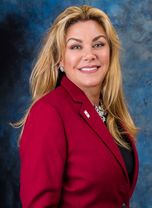 Message from our Chair - Stacy Miller National Geographic Explorer, Sunset Magazine, Heal The Bay, Sparling’s Best Places to Live all are raving about Oxnard Would you be surprised to learn that in addition to being Ventura County’s largest City, Oxnard was named one of the 20 Happiest Cities in the United States by National Geographic Explorer? “It’s no surprise that California is home to many of the happiest places in America, including Oxnard/Thousand Oaks/Ventura. With its combination of great weather, beaches, and nearby national forests, adventure awaits around every corner” stated the article by National Geographic Explorer and best-selling author Dan Buettne. The rankings were based on National Geographic’s study that established 15 metrics that signal happiness - the metric included eating healthy, learning something new every day, civic engagement, financial security, vacation time, and even dental checkups. Did you also know that we have some of the highest rated beaches in the STATE? Heal the Bay rates Oxnard’s beaches as some of the best in California. The water is tested weekly and our beaches were rated A+ every single week of the year. Oxnard is one of only 37 beaches in California to receive an A+. In addition, Sunset Magazine rated Oxnard 7th in their rating of the Top 20 Game-Changing Places to Live. “This coastal community south of Ventura has easy access to the Santa Monica Mountains and Channel Islands. Its Latino majority infuses the bustling downtown with authentic eateries and annual festivals around strawberries, tamales, and salsa,” they stated. Oxnard also boasts a fabulous natural resource – a national park and national marine sanctuary right off our shores and very accessible. Many of us that live and work here believe Oxnard is our “little gem.” We enjoy excellent air quality, year-round first-rate climate, diversity, easy access to outdoor activities, a low unemployment rate and comparatively speaking, little traffic. According to Sparling’s Best Places to Live, job growth in Oxnard has been positive. Jobs have increased by 0.36% over the past year. The average salary in Oxnard is $62,349. The median home cost in Oxnard is $429,300. The unemployment rate in Oxnard is 5.90%, with job growth of 0.36%. Future job growth over the next 10 years is predicted to be 34.81%. With all of these “tail winds,” I believe that far and away our best assets continue to be the amazing people who live and work in Oxnard and are committed to improving this amazing place. The Chamber looks forward to our collective efforts at increasing the success of local businesses, the economy and our quality of life here in the ‘Nard. Until next time… Stacy 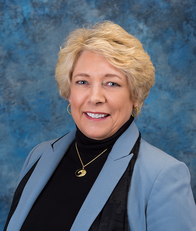 I ran the following article in the June 2014 issue of the Business Voice. After attending many meetings and gatherings where Old Glory was the focus of pomp and circumstance, I thought I would share it again. When the occasion calls for a color guard, I am amazed at the wide variety of reactions by my fellow attendees. There seem to be very few civilians who know what to do when a flag is paraded past them. Since Flag Day is Thursday and the Fourth of July is right around the corner, I thought this to be an appropriate time to answer all of those protocol questions you may have been afraid to ask! Displaying the Flag Outdoors When the flag is displayed from a staff projecting from a window, balcony, or a building, the union (stars) should be at the peak of the staff unless the flag is at half staff. When it is displayed from the same flagpole with another flag - of a state, community, society or Scout unit - the flag of the United States must always be at the top except that a church pennant may be flown above the flag during church services, or for Navy personnel when conducted by a Naval chaplain on a ship at sea. When the flag is displayed over a street, it should be hung vertically, with the union to the north or east. If the flag is suspended over a sidewalk, the flag's union should be farthest from the building. When flown with flags of states, communities, or societies on separate flag poles which are of the same height and in a straight line, the flag of the United States is always placed in the position of honor - to its own right. The other flags may be smaller but none may be larger. No other flag ever should be placed above it. The flag of the United States is always the first flag raised and the last to be lowered. When flown with the national banner of other countries, each flag must be displayed from a separate pole of the same height. Each flag should be the same size. They should be raised and lowered simultaneously. The flag of one nation may not be displayed above that of another nation. Raising and Lowering the Flag The flag should be raised briskly and lowered slowly and ceremoniously. Ordinarily it should be displayed only between sunrise and sunset. It should be illuminated if displayed at night. The flag of the United States of America is saluted as it is hoisted and lowered. The salute is held until the flag is unsnapped from the halyard or through the last note of music, whichever is the longest. Displaying the Flag Indoors When on display, the flag is accorded the place of honor, always positioned to its own right. Place it to the right (as in stage-right or to the audience's left) of the speaker or staging area or sanctuary. Other flags should be to the left. The flag of the United States of America should be at the center and at the highest point of the group when a number of flags of states, localities, or societies are grouped for display. When one flag is used with the flag of the United States of America and the staffs are crossed, the flag of the United States is placed on its own right with its staff in front of the other flag. When displaying the flag against a wall, vertically or horizontally, the flag's union (stars) should be at the top, to the flag's own right, and to the observer's left. Parading and Saluting the Flag When carried in a procession, the flag should be to the right of the marchers. When other flags are carried, the flag of the United States may be centered in front of the others or carried to their right. When the flag passes in a procession, or when it is hoisted or lowered, all should face the flag and salute. The Salute To salute, all persons come to attention. Those in uniform give the appropriate formal salute. Citizens not in uniform salute by placing their right hand over the heart and men with head cover should remove it and hold it to left shoulder, hand over the heart. Members of organizations in formation salute upon command of the person in charge. There is actually a Section in the US Flag Code addressing this issue, which states: During the ceremony of hoisting or lowering the flag or when the flag is passing in a parade or in review, all persons present except those in uniform should face the flag and stand at attention with the right hand over the heart. Those present in uniform should render the military salute. When not in uniform, men should remove their headdress with their right hand and hold it at the left shoulder, the hand being over the heart. Aliens should stand at attention. The salute to the flag in a moving column should be rendered at the moment the flag passes. NOTE: This is what you are supposed to be doing when the color guard is doing their job!! The Pledge of Allegiance and National Anthem The pledge of allegiance should be rendered by standing at attention, facing the flag, and saluting. When the national anthem is played or sung, citizens should stand at attention and salute at the first note and hold the salute through the last note. The salute is directed to the flag, if displayed, otherwise to the music. The Flag in Mourning To place the flag at half staff, hoist it to the peak for an instant and lower it to a position half way between the top and bottom of the staff. The flag is to be raised again to the peak for a moment before it is lowered. On Memorial Day the flag is displayed at half staff until noon and at full staff from noon to sunset. (I did not know this!) The flag is to be flown at half staff in mourning for designated, principal government leaders and upon presidential or gubernatorial order. When used to cover a casket, the flag should be placed with the union at the head and over the left shoulder. It should not be lowered into the grave. What about that Gold Fringe on some flags? The quote below concerning gold fringe on the flag is from the book So Proudly We Hail, The History of the United States Flag by William R. Furlong and Byron McCandless: "The placing of a fringe on Our Flag is optional with the person of organization, and no Act of Congress or Executive Order either prohibits the practice, according to the Institute of Hearaldry. Fringe is used on indoor flags only, as fringe on flags on outdoor flags would deteriorate rapidly. The fringe on a Flag is considered and 'honorable enrichment only', and its official use by the US Army dates from 1895. A 1925 Attorney General's Opinion states: 'the fringe does not appear to be regarded as an integral part of the Flag, and its presence cannot be said to constitute an unauthorized addition to the design prescribed by statute. An external fringe is to be distinguished from letters, words, or emblematic designs printed or superimposed upon the body of the flag itself. Under law, such additions might be open to objection as unauthorized; but the same is not necessarily true of the fringe.'" The gold trim is generally used on ceremonial indoor flags that are used for special services and is believed to have been first used in a military setting. It apparently has no specific significance and its (gold trim) use is in compliance with applicable flag codes and laws. Now go out there are salute the symbol of our great country!!! |
|
Copyright © 2024 West Ventura County Business Alliance. All Rights Reserved.
1901 Solar Drive, Suite 105 | Oxnard, CA 93036 Phone: (805) 738-9100 | [email protected] Site Map |


